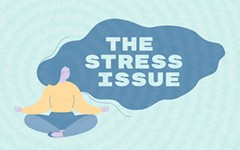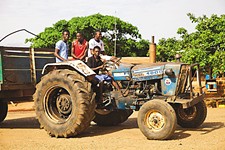Austin's Political Ecosystem
Scott Swearingen's 'Environmental City' tells the inner history of Austin politics
By Nora Ankrum, Fri., April 23, 2010
Sometime in the 1950s, Janet Fish thought it would be nice to fix up an overgrown bridle path that passed by her house along Shoal Creek. The city declined to fund the project, so she wrote a $5,000 check to the Parks and Recreation Department, essentially hiring the city to lend her a hand. Together with community groups and neighbors along the creek, Fish created Austin's first "hike-and-bike trail." Thanks to Lady Bird Johnson's admiration for the project, the term caught on nationally; here in town, the Shoal Creek trail inspired the greenbelts that would eventually be a defining feature of Austin's landscape.
This story, and others like it – many with grander aspirations and more formidable villains – are recounted in Environmental City: People, Place, Politics, and the Meaning of Modern Austin, a new book by St. Edward's University urban sociologist Scott Swearingen. He wrote the book, he says, to show that "the desire for environmental protection and to create and preserve a special kind of place with a special kind of feel to it has been going on since the 1960s. It's not something that just started with SOS."

While the legendary Save Our Springs Alliance battles of the Nineties play a pivotal role in Austin's environmental narrative and institutional memory, Swearingen begins the story much earlier (and follows it through the most recent City Council elections). In doing so, he demonstrates that the grassroots energy and values that fueled those fights over the Edwards Aquifer watershed (and eventually ushered in the first "green council" of the Nineties, introduced the "smart growth" era, elevated anti-nuke activist Roger Duncan to the head of Austin Energy, and ensured that someone who once chained herself to a tree in protest of the construction of Barton Creek Square mall – Toby Futrell – could become city manager) find their roots in the decades preceding.
In many ways, Fish's experience established an archetype repeated in countless environmental battles to follow. It's a story about city priorities: For a long time, city officials and engineers believed that creeks were for pipes, not people. It's a story about the power of grassroots activism: The trail now continues across Seton Hospital's land because Fish's husband persuaded its developers to grant a right-of-way – and not to build on top of Seiders Springs (where the trail ends, by the way, because land owners north of the park "didn't want 'common people' wandering along their property").
The Fishes' story encompasses all the major players of later battles: neighborhood activists, city officials, landowners, developers ... and money. Shoal Creek's story is one of many in which West-side victories are won with West-side privilege – in this case, a $5,000 check. Not all efforts have been so lucky.
The Next Preservation Line

While Swearingen touches on this theme, he does so with a light hand – for example, Eastside activist group PODER doesn't make the cut (People Organized in Defense of Earth and Her Resources was established in a fight against a gasoline tank farm – a fight in which Swearingen, in fact, took part) – and only in the endnotes does Swearingen explain how Austin's early planners used the nicest parks to lure whites west and segregate the city. He explains these omissions partly as a matter of space (30,000 words were chopped from his original manuscript) and coherence – Austin's environmental history told through the lens of the east-west dichotomy is a different story, warranting a whole book unto itself. But he also makes the case that Environmental City is, first and foremost, about social justice. Austin's major environmental victories were made possible only by alliances crossing the I-35 divide, he says, because at heart, the environmental movement "is based on this basic idea that everyone has the right to clean air, clean water, and space ... not just the few rich people who can own a ranch in California or Colorado."
Those local progressives who found their way into politics through the civil rights struggle, argues Swearingen, are the ones who eventually landed in the environmental movement because they believed "you should not be able to pollute the air or the water for private profit to the harm of other people." Unlike the more traditional political battles that have defined progressive movements in other cities, says Swearingen, Austin's have centered on preserving the city's natural features as a public good. That means Environmental City is as much a lesson in how Austin's politics work – and why they work that way – as it is a narrative about visionaries who could see beyond urban sprawl.
It's no longer said that Austin has two political parties: environmentalists vs. developers. In a way, says Swearingen, the developers won – with help from the Texas Legislature and from council members who, for example, fought environmental protections long enough for developers to lay claim over most of the aquifer. But the environmentalists won, too, he says. They succeeded in institutionalizing environmental principles and priorities within Austin's municipal government, its political machinery, its physical landscape, and the lifestyles of those who live here, creating a legacy that continues to define what a city can and should be.
If you enjoy jogging around Lady Bird Lake, you can thank environmentalists. If you like that there's still Hill Country left in the Hill Country, thank environmentalists. And if you think that the kids in East Austin deserve the same privileges Swearingen enjoyed growing up on the West side in the Sixties and Seventies, support environmentalists. As Swearingen writes, Austin is now "growing east faster than west," and not only does the East also have creeks, aquifers, and the Colorado River, but it has "the Blackland Prairie, the most endangered ecosystem in North America." And it's all ripe for developing – or preserving.
"We still have a chance right now to get ahead of the cost curve," says Swearingen. "We've built a special kind of city on this side. We need to continue to build that kind of city. ... If we don't, what we will have done is, we will have built a special city for some, and regular old suburban crap for others."
Swearingen will be signing copies of his Environmental City during the Austin Green Living Expo at the Austin Convention Center, April 24-25 (4pm, Saturday; 3pm, Sunday).
Got something to say on the subject? Send a letter to the editor.









